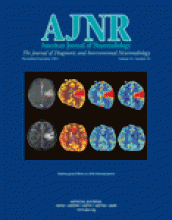Abstract
BACKGROUND AND PURPOSE: The common entity cerebral venous sinus thrombosis is associated with the poorly characterized imaging finding of parenchymal abnormalities; diffusion-weighted imaging has offered some insight into these manifestations. We assessed the relationship between the diffusion constant from apparent diffusion coefficient (ADC) maps in patients with cerebral venous thrombosis (CVT) with follow-up imaging findings and clinical outcome.
METHODS: We evaluated the medical records and T2-weighted MR images of 13 patients with CVT complicated by intraparenchymal abnormality. Diffusion-weighted (DW) images and ADC maps were evaluated for increased, decreased, or unchanged signal intensity and were compared with signal intensity of contralateral, normal-appearing brain. In addition, ADCs were obtained in nine pixel regions of interest in abnormal regions in eight of the 13 patients.
RESULTS: Eight patients had superficial CVT, and five had superficial and deep CVT. CVT of deep veins was associated with deep gray nucleus and deep white matter abnormalities, whereas superficial CVT was associated with cortical and subcortical abnormalities. Twenty-four nonhemorrhagic lesions were identified in 10 of 13 patients on the basis of follow-up imaging findings. Four patients without seizures had lesions with decreased diffusion that appeared hyperintense on follow-up T2-weighted images, three patients with seizures had lesions with decreased diffusion that resolved, and seven patients had lesions with increased diffusion that resolved. Three of 10 patients had more than one lesion type. No difference was noted in mean ADCs for lesions with decreased diffusion that resolved compared with lesions with decreased diffusion that persisted.
CONCLUSION: DW imaging in these patients disclosed three lesion types: lesions with elevated diffusion that resolved, consistent with vasogenic edema; lesions with low diffusion that persisted, consistent with cytotoxic edema in patients without seizure activity; and lesions with low diffusion that resolved in patients with seizure activity. This information may be important in prospectively determining severity of irreversible injury and in patient treatment.
- Copyright © American Society of Neuroradiology












